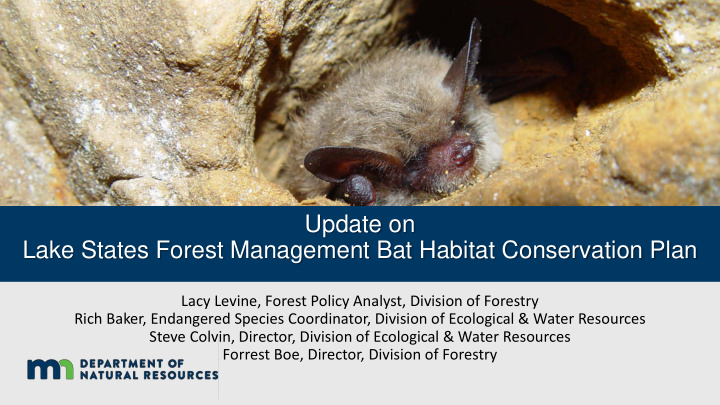



Update on Lake States Forest Management Bat Habitat Conservation Plan Lacy Levine, Forest Policy Analyst, Division of Forestry Rich Baker, Endangered Species Coordinator, Division of Ecological & Water Resources Steve Colvin, Director, Division of Ecological & Water Resources Forrest Boe, Director, Division of Forestry
Agenda Topics We’ll Cover Today Why MN bats are in trouble HCP development process Highlights of chapters 4 & 5 Next steps
Why bats are in trouble White Nose Syndrome Has been spreading since 2006 First mortalities in Minnesota in March 2016 Up to 98% mortality in Minnesota as of 2020 All cave-hibernating bats are impacted WNS causes bats to wake from hibernation and deplete energy reserves
Bats and Forest Management Activities • Many of Minnesota's bats spend spring, summer and fall in forests • Female bats give birth to young in tree roosts. • Before they are able to fly, young bats may be vulnerable to impact by normal forest management activities that include tree removal.
Covered Bats Northern Long-Eared Bat: Listed Little Brown Bat: Under status Tri-colored Bat: Petitioned for as threatened with 4(d) Rule by review by USFWS (found in all 3 listing (found in all 3 states) USFWS (found in all 3 states) states) • Indiana Bat: Listed as endangered by USFWS (found in Michigan only)
Current Federal Regulations Northern Long-eared Bat was designated as a threatened species under the federal Endangered Species Act (ESA) in 2015 Threatened status provides exemption: special regulation (“4(d) Rule”) that allows tree removal that might otherwise result in take (finalized 2016) The term take means to harass, harm, pursue, hunt, shoot, wound, kill, trap, capture, or collect, or to attempt to engage in any such conduct. Other bat species covered by the HCP could be listed as threatened or endangered if declines continue
HCP Reasoning If any covered bat species are listed as endangered, an ITP or consultation with USFWS would be required to continue activities that might result in a “take” of the species ITP application must include an HCP Minnesota, Wisconsin, and Michigan working jointly on an HCP Proposed Permit Term – 50 years
Contents of the HCP & Where We Are Ch 1: Introduction Initial comments received in 2018 Ch 2: Covered Activities Ch 3: Environmental Setting Ch 4: Impacts Analysis Ch. 4 & 5 now available Ch 5: Conservation Strategy for stakeholder input Appendix E: Attributes of High-Quality Bat Habitat in Managed Lake State Forests Ch 6: Implementation Ch 7: Funding Available soon (summer 2020) Ch 8: Alternatives
Relationship Between HCP Ch. 4 & 5 Ch. 4 analysis shows covered activities result in take (~3 bats/year) Ch. 5 demonstrates that this take is offset by the conservation objectives of the HCP Appendix E describes habitat features that constitute high quality habitat for covered bats
HCP Chapter 4: Impacts Analysis Analyzed where both bats and covered activities occur Bats are Present Direct effects of covered activities on bats is ~3 bats per year over 50 years in Minnesota Indirect effects of covered activities Covered Activities are neutral or beneficial
HCP Chapter 5: Conservation Strategy Overview Conservation strategy is organized by: • Biological Goals – guiding principles • Biological Objectives – how goals will be accomplished; what DNRs are promising to do and report on annually • Conservation Measures – potential actions that can be taken to achieve the Biological Objectives Take is offset by the conservation strategy
HCP Chapter 5: Conservation Strategy Biological Goal #1: Maintain Healthy Forests • Objective 1.1: Continue to manage DNR forests sustainably Biological Goal #2: Protect Roosts and Foraging Habitat • Objective 2.1: Continue to implement Minnesota Forest Resources Council’s Voluntary Site Level Forest Management Guidelines • Objective 2.2: Protect all known maternity roost trees with 150-ft. buffer year-round Biological Goal #3: Promote stewardship on other lands • Objective 3.1: Implement Landowner Enrollment Program • Objective 3.2: Implement Bat Conservation Outreach Program
HCP Chapter 5: Conservation Strategy (continued) Biological Goal #4: Protect Hibernacula • Objective 4.1: Remove obstructions from hibernacula entrances • Objective 4.2: Protect all known hibernacula entrances with 0.25 mile buffer year-round • Objective 4.3: Maintain gates at hibernacula entrances • Objective 4.4: Develop and collaborate on White-nose Syndrome Response Plan Biological Goal #5: Avoid/Minimize Negative Effects of Covered Activities • Objective 5.1: Incorporate bat concerns into prescribed burn plans • Objective 5.2: Restrict tree removal associated with road and trail construction and maintenance when bats are present (seasonally)
Next Steps Ch. 4 & 5 Stakeholder Review : March 16 – April 30: 45 day stakeholder review period Chapters available at: Minnesota DNR Bat HCP Project Webpage Submit comments to: bathcp.dnr@state.mn.us Moving forward: Ch. 6–8 will be made available for stakeholder review in ~Summer 2020 Once all chapters of the HCP are compiled, the HCP will go through the NEPA process. The compiled HCP will be made available through the Federal Register for public comment.
Thank You! Submit comments to: bathcp.dnr@state.mn.us Lacy Levine Rich Baker lacy.levine@state.mn.us richard.baker@state.mn.us 651-259-5073 651-259-5265
Recommend
More recommend